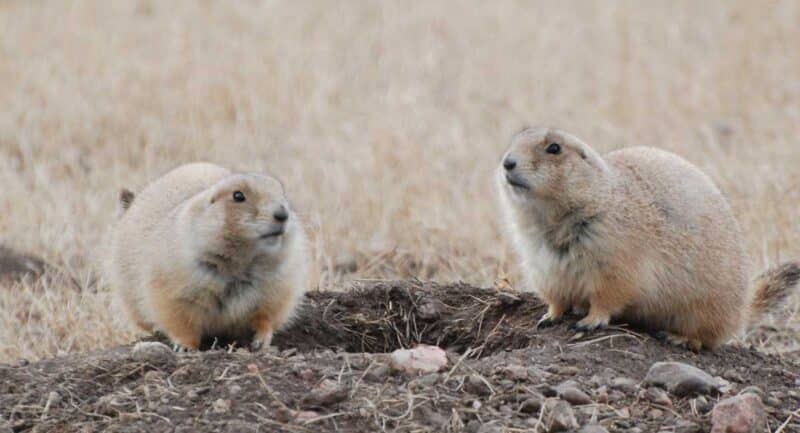by Dr. Sarah Treanor Bois
Director of Research & Education at the Linda Loring Nature Foundation
As an invasive species plant ecologist, I work a lot with non-native plants, their invasion history and how and why plants were transported to the island. One fascinating and little-known fact about invasions on Nantucket actually comes in the form of a small, cute mammal. One of the biggest invasive species problems Nantucket has ever faced was the black-tailed prairie dog.
Prairie dog? Yes, the once-abundant rodent of the Great Plains was a Nantucket wash-ashore in the late 1800’s. According to “The Prairie Dog of the Great Plains,” published in 1901 and written by C. Hart Merriam, two pairs of prairie dogs were introduced to Nantucket between 1890 and 1892. They reproduced slowly at first and were regarded as a novelty. On Nantucket, with few predators, there was a lack of natural enemies. Thus, it’s not surprising that within a few years the population exploded. It’s estimated that the population was somewhere in the thousands at its peak by 1899.
Apparently, the population became large enough that island residents began to complain. People were “alarmed and feared that the animals would overrun the whole island.”
In a letter to C. Hart Merriam, Outram Bangs detailed his visit to Nantucket in 1899, when he counted 200 visible prairie dogs in one colony. He believed that there were three or four colonies of similar size plus an additional few smaller colonies as well as scattered pairs throughout parts of the island.
A specimen collected at the time proved it to be the plains species of prairie dog (Cynomys ludovicianus). This species is now known as the black-tailed prairie dog. Our Nantucket critters likely came from somewhere on the Great Plains between Kansas and Texas. The preferred habitat for the black-tailed prairie dog is dry, short to mid-grass prairies. Nantucket, with its dry sandplain grasslands, fits this habitat description, if not the historic range.
Currently, black-tailed prairie dogs are found from Nebraska to Montana. Their range used to be much larger, but widespread eradication primarily by ranchers, has limited their range to mainly protected lands.
Females are only able to breed once a year, so it is curious how quickly the population grew on Nantucket. However, one male can impregnate multiple females. They reach breeding maturity by age two (if not before), and females can have three to four pups per litter. This reproductive strategy explains why, on Nantucket, there was a lag phase after initial introduction. It wasn’t until a few years later when the population became so abundant that it became a visible problem.
In their native range, many prairie dog young don’t survive the first year of life. However, as we know on Nantucket, there are few predators. A few pups could have been picked off by birds of prey. However, in the Midwest, their primary predators are coyotes, badgers, various rattlesnakes, eagles, and hawks. Without most of these predators present, prairie dogs have been found to live up to eight-years-old.
Prairie dogs are very social animals. Their colonies, or towns, may contain hundreds of individuals living within a relatively small area. Within the town there are different “neighborhoods.” The females remain with their familial neighborhood, and the males disperse. Each neighborhood, or coterie, is populated by closely related females (sisters, aunts, mothers, etc.).
All of these towns are underground with a complex system of tunnels, nesting chambers, and mounds. The burrows measure an average of five to 10 meters in length (16-32 feet) and two to three meters deep (6.5 to 10 feet). Entrances to the burrows are 10-30 centimeters in diameter (4-12 inches).
Herein lies the demise of prairie dogs on Nantucket. If it weren’t for deep burrows and wide openings to said burrows, our high school mascot may be the prairie dogs instead of the Whalers. In a time when horses were the primary mode of transportation, and livestock (sheep and some cattle) were the main industry of the day, deep holes in fields were a danger. There were no specific reports of animals injured on Nantucket, but that is often cited as a primary danger by ranchers – that livestock will break legs in prairie dog holes.
In the late 1890s on Nantucket, many locals also argued that the prairie dogs were destroying crops and fields. Black-tailed prairie dogs eat primarily leaves, roots, and stems of grasses and forbs. They are ecosystem engineers aerating the soils where their burrows are located. Vegetation within burrows is shorter than surrounding grasslands where black-tailed prairie dogs still exist. For unknown reasons, there are some rare prairie species that only persist in areas with prairie dog burrows, so there is some other affect these creatures are having in the grasslands.
If they were still here today, we, as conservationists and land managers, would likely be working with (or around) these critters as we manage for sandplain grasslands, much as land managers in prairie systems are doing in present day. Without a map or description of the 1890s locations of burrows, we may never know which grasslands and fields were home to the black-tailed prairie dogs.
By 1900, Nantucketers had declared “war” on these introduced mammals with a bounty placed on them. At a town meeting in 1900, the town created a committee whose sole purpose was to investigate ways to exterminate the prairie dogs. A portion of the town budget—$350—was allotted specifically for their control. In an oral history recording available on the Nantucket Historical Association website, Albert Lewis talked about “Old Henry Brown,” a member of the committee of three people. Apparently, Mr. Brown told Lewis that he was “disgusted” by the prairie dogs after working to try and exterminate them for some time. The committee finally decided on a concentrated, island-wide effort. Another $200 was procured for poison and a plan was hatched.
Farmers and others interested worked together on a poisoning scheme. Carbon bisulphide was used to saturate rags which were then placed in the mouths of all the burrows and the holes closed with dirt. The method was successful and all prairie dogs were believed “exterminated” in that year.
As W.W. Neifert wrote in February 1900, “…now there is not a dog left to tell the tale.”



